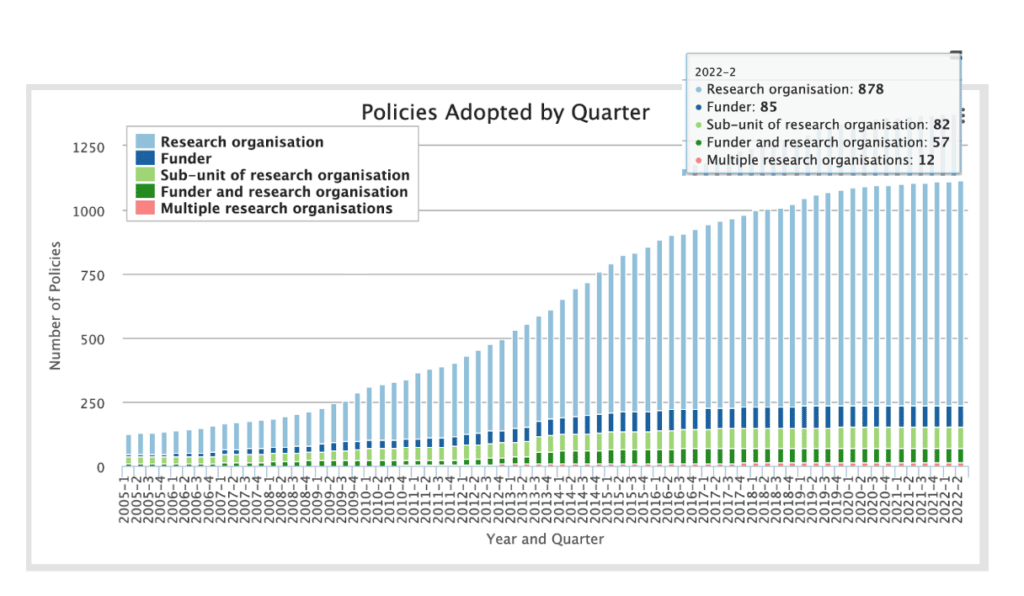Subscribe to our newsletter
The Changing Landscape of Open Access Compliance
Globally, the past decade has seen a move from 70% of all publishing being closed access to 54% being open access. In recent years, the COVID-19 pandemic has changed science publishing and necessitated a huge acceleration in transitioning to Open Access (OA) models, driven by a need for speed in publishing and an accompanying growth in preprints. The even more recent memo from the White House’s Office of Science and Technology Policy (OSTP) will see this trend advance rapidly in the United States, with not only federally funded publications themselves but associated datasets being required to be made publicly available without embargo.
In this blog post, Symplectic‘s Tzu-I Liao examines global shifts in approach to Open Access, and discusses how Symplectic plans to continue to evolve Elements’ functionality to build in more flexibility and support for multiple OA pathways.
Tracking global trends – and differences – in the OA landscape

Figure 1 shows a dramatic 10x increase of OA policies adopted between 2005 and 2022 by institutions, according to ROARMAP. Numbers of policies adopted by funders increased from 19 in 2005 to 142 to 2022. We are excited to see the growing effort in making research more open – but on the other hand, as research organisations are required to give account of how the funded projects are compliant and managed efficiently, we now are faced with a much bigger range of requirements and criteria to monitor within Symplectic Elements.
Interestingly, amidst the changing landscape of OA requirements, the latest updates to government funder policies suggest trends of similar requirements globally. For example, UK Research and Innovation (UKRI), the Government of the UK that directs research and innovation funding, updated its OA policy in 2020, mandating all funded research outputs be made open immediately upon publication without any embargo. Comparably, in August 2022 the OSTP within the US government issued guidance for federal agencies to set up their own OA policy to make funded research available to the public immediately once published, permitting no delay.
On the other side of the world the National Health and Medical Research Council (NHMRC), the main authority of the Australian Government responsible for medical research, also revised its policy in September 2022 and listed these same criteria for compliance. These funders also underline the importance of making research data open. Both UKRI and NHMRC prescribed the reuse licence to be applied to the outputs. While it is reassuring to see major funders moving towards similar directions, the OA landscape in front of us is still full of uncertainties.
While many policies point to similar criteria, much more variables now need to be taken into consideration when calculating compliance. Table 1 below demonstrates the difference of policy requirements between three major funders in different regions: both UKRI and NIH turn to making publications available immediately, while ARC retains the option of embargo; while UKRI and ARC pay more attention to metadata and research data, it is not yet specified in NIH’s policy.
| Authority | UKRI (UK) | NIH (USA) | ARC (Australia) |
| Mandate (articles) | Version of Record immediately available upon publication or Accepted Manuscript deposited in repository | Must be submitted to NIHMS upon acceptance & publicly available on PubMed Central | Should be open access within 12 months of publication |
| Mandate (metadata) | Must be used on deposit platforms | N/A | Must be public within 3 months of publication |
| Mandate (data) | Need to have data accessibility statement | N/A | Open access is encouraged |
On top of the divergent paths for making research output ‘open’ or ‘publicly available’ (which are not always clearly defined), many policies also mention requirements about metadata and/or research data. However, clearer guidance on these areas are yet to be published. There are more policies encouraging the adoption of Gold OA pathway, but hybrid models and transformative deals make monitoring increasingly complicated. Some funders specify that outputs and metadata need to be deposited on platforms meeting certain requirements, although there is no comprehensive list of such platforms.
Monitoring open access with Elements so far
Currently Symplectic Elements already helps institutions support and streamline open access workflows. With our flexible repository tools, administrators can customise harvest and deposit processes for the institutional repositories and use them as data sources to maintain an accurate representation of the outputs and minimise duplicates and efforts.
At the same time, our OA Monitor module focuses on supporting an oversight of the institution’s activities for green OA. This involves keeping an eye on very detailed metadata about different types of publications with different funding sources and potentially multiple authors of different statuses. Our OA Monitor module supports defining an OA Policy: from what groups of users and publications are included in the policy, to detailed instructions about what compliance means. You can exclude inactive users or publications with embargo requests. We offer a complex algorithm to check compliance based on deposit deadlines, embargo period, deposit file versions etc. With the defined policy, users can set up prompts for researchers at various steps of workflows to deposit full text to the institutional repository for publications covered by the policy. The goal is to provide users with actionable information about how they can increase the proportion of deposited works.
How OA changes impact upon Elements
As all these different mandates emerge, there are more criteria and more specifications at different levels that need attention. Our current approach to focus on monitoring the Green OA pathway may see more gaps going forward.
For example, the updated UKRI policy now no longer allows any embargo for the Green OA pathway– all outputs should be made open by the time of publication. To be compliant, there are no more grace periods (as for REF submissions) or any embargo that could serve as a buffer zone. This could mean that the deposit monitoring workflow likely needs to start much earlier in the publishing cycle. Alternatively, institutions might also see more researchers considering taking the Gold OA pathway, and thus need to monitor such activities more rigorously.
In other words, the sets of data points to capture and/or curate in order to fulfil the institutional needs in the OA monitor are now different.
More and more institutions feel the need to set up their own policies: partly responding to the funder mandates, partly trying to simplify the workflows required for widening needs. More stakeholders of various levels and focuses need to be brought onboard, with wider impacts on more parts of an organisation.
The work entailed to support researchers and departments to be as compliant as possible has also changed significantly. Perhaps you want to help researchers choose an open journal to publish in, prompting researcher to deposit the right version of the work with the right licence together with the research dataset, and also include a statement about data availability or handle support with Author Processing Charges (APCs) or copyright retention etc
All these lead to more complex and institution- or even funder-specific monitoring workflows. We see institutions develop very specific reporting needs around these processes, some of which can be fulfilled partly by custom reports. These reports work well for specific needs, but are often less flexible and require more maintenance effort. While our OA Monitor and reports cater very well to the current scope of monitoring, there are some limitations because of the single-policy framework. Not all OA Monitor concepts, like first deposit date or reuse licences, are in the Reporting database – which means we are not always utilising everything we already have curated.
Responding to OA changes with Elements
As the landscape of Open Access continues to evolve, with national and even regional disparities and a growing proliferation of pathways to OA, supporting OA monitoring and reporting within Elements necessitates greater flexibility and ongoing attention to global mandates. Here are some of the changes in Elements functionality that have either been made, are in progress, or are planned in our upcoming roadmap:
Extending support for repository integrations
Repository integrations remain an important part of OA monitoring, and we continue to support streamlining deposit workflows. For the majority of institutional and funder policies, the Green OA pathway remains the central part of the workflow. Organisations using Elements can continue with the established data verification and curation workflows, and use our powerful Repository Tools 2 (RT2) integration with repositories to customise harvesting, depositing and automated updates. These functionalities are now offered to clients using DSpace (fully supported from Elements v.6.9), Eprints, Hyrax, and Figshare for Institutions (fully supported from Elements v.6.9).
Capturing more OA-related metadata from existing data sources
We have expanded the range of metadata available to provide organisations with a fuller picture of their OA activities and OA publishing patterns.
One disruptive side-step in the workflow for many institutions is needing to go out of Elements to check whether an article has been published in a fully OA journal. Elements now allows institutions to capture this information manually or from integrated sources (eg. Dimensions, WoS & DOAJ) to flag potential Gold OA status (available from v.6.9).
New inclusion of relevant data points will assist tracking key funder requirements. For example, The Wellcome Trust and NIH require deposits of publications to PubMed Central/ EPMC. From v.6.10 Elements starts to capture file level metadata from EPMC, offering additional information on full-text deposits, relevant dates and licences that could be integrated into your verification workflow. Another example is the improved control over deposit versions and reuse licences in recent releases, which will help make it easier for researchers to remember to select CC-BY licence for the Author’s Accepted Manuscript and make that deposit compliant for the UKRI policy.
Next steps in Elements
Following on from extensive user research in this space, we plan to build upon our existing rich feature set to offer additional open access monitoring functionality to help institutions understand the many different pathways their researchers use to make their research openly available. We also plan to evolve our OA policy compliance capabilities to remain in step with the changes in key funder policies.
The future of the OA landscape
Following on from extensive user research in this space, we continue to engage with clients in an ongoing series of user-led workshops which aim to craft guidance on the more nebulous areas of open access – such as data availability statements and rights retention policies.
We will continue to closely monitor this shifting landscape, proactively working to create functionality to fit incoming mandates across geographies and working closely with the Elements community to identify ways to support OA engagement, compliance and reporting.
If you’d like to engage with us on any of the areas raised in this blog, please get in touch.

About the Author
Tzu-i Liao, Jr. Product Manager | Symplectic
